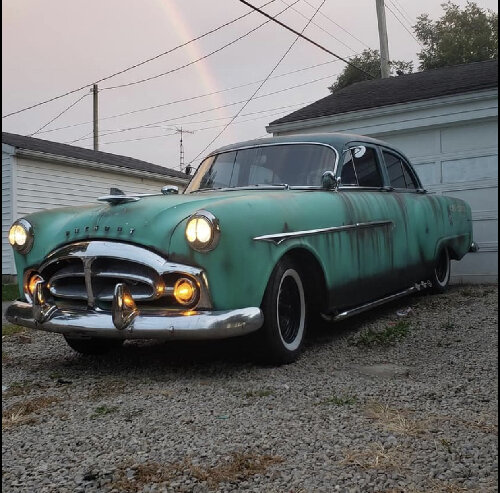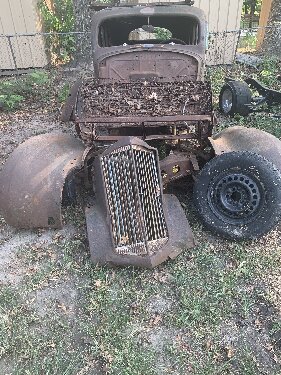|
Re: Engine rattle
|
||||
|---|---|---|---|---|
|
Forum Ambassador

|
Glad your problem is solved, and you also learned a bit in the process. The makings of a good day.
Posted on: 2008/12/23 23:35
|
|||
|
||||
|
Re: Engine rattle
|
||||
|---|---|---|---|---|
|
Home away from home

|
Quote:
Glad your problem is solved, and you also learned a bit in the process. The makings of a good day. JeffM, Glad you fixed it too! Owen gives us all a good definition here. Some days (weeks) we check out 2 dozen things and one (or two) fix the problem. I have to remind myself that these Packards are built to run. My job is to jusy get all of the 'quirks', cracks, rust, and rot out of the way to make it happen. Merry Christmas! DanL
Posted on: 2008/12/24 9:28
|
|||
|
[i][size=small][color=000066]Dan'L in SD
41ParPack First of the Clippers [ |
||||
|
||||
|
Re: Engine rattle
|
||||
|---|---|---|---|---|
|
Home away from home
|
Thanks. Yes, that's the beauty of it. Start out not knowing, have a few good, patinet teachers to answer questions, jump in, and get it fixed - all the while learning some valuable information. I knew it wouldn't be that hard to fix. It's just I never timed an engine before. Now, I can do it in 1/20th the time. Merry Christmas, all!
Posted on: 2008/12/24 14:09
|
|||
|
||||
|
Re: Engine rattle
|
||||
|---|---|---|---|---|
|
Home away from home

|
This is kind of long but I think it could help:
A quick way to set the timing without any special tools or instruments is to loosen the distributor bolt so you can turn it with some effort--not too loose or it will slip out of place easily when you start up. Pull the vacuum advance tube (often recommended in tune-up manuals). Start the engine and let it warm up until it is at regular idle. Put on leather gloves to avoid shock and turn the distributor. You don't even have to know the direction for advance or retard. Just listen and the RPM will drop when moving it to retard the spark and speed up as you move it to advance. As you advance the timing, stop when you hear the engine start to stumble slightly or sound a little "rough." This is often the best setting for economy and performance, but it may cause detonation. The way to tell is to tighten the distributor bolt and drive the car until its at operating temperature and do some hard acceleration and drive some hills. If it doesn't detonate but has a hesitation in throttle response, it could probably use a little more adjustment--probably advance. Remember if you change or adjust point dwell (gap) do it before you time the engine. If your points are bad, might as well put in a new rotor and condensor, and check the distributor cam lobes to make sure they aren't worn and none are flattened out. Lube them and the "rubbing block" on the points with a little grease. Do this even if you don't adjust or replace the points. The reason Packard V8'scan need different timing is the range of compression ratios. They all call for 5? initial advance, but the compression varies in '55 from 8.1:1 on the 320 ( Clipper De Luxe, Super and Panama), to 8.5:1 (on the 352 Clipper Custom and Constellation ,Packard 400, Patrician, and Caribbean). In '56 all the Clipper 352's were upped to 9.5:1 and the 374 Executive, Patrician and Caribbean were 10:1. The 9.5 or 10:1 was a lot of compression for those days and now will probably require unleaded high test, probably with an octane booster (there are non-lead types). Or, if you're lucky, you might find some "clear" non-oxygenated gas that is usually high octane and is legal in "classic" cars and some off-road vehicles. I've found it most often at Mobil stations that have one pump with it. Also, older engines can have carbon buildup in the combustion chambers, effectively increasing compression ratio slightly and causing "hot spots" in the chambers. A little "steam cleaning" by drizzling water into the carb throat with the engine running and warmed up can help, or a "top cylinder lubricant' such as Marvel Mystery Oil can be squirted in the carb until the engine stalls and left in it overnight. Be ready for lots of smoke when you start it, but it'll be cleaned out and maybe unstick some rings. Another possible source of detonation and poor performance is a lean mixture, especially if you drive at high elevations. Short of changing jets, you can go with a little less timing, especially in mountain driving. Finally regarding the column shift Twin Ultramatic, there are two small trianges on either side of the D. The right one is for "quick aways" in stop and go traffic. The left one is for cruising easily around with grandma in the back seat. It's easy to remember which "range" you're in because the extra downshift to a lower starting gear is set with the shift indicator on the triangle nearest the L. It's really not a good idea to shift these transmissions manually for mechanical and driveability reasons. The shifter isn't that precise, and you can over or under shoot the position you want, even possibly ending up in N or P! The impression you get that your idle is fast may just be due to the whine that seems to occur when you shift into Neutral or Park. I'm not sure what this is from, but I think it has to do with the transmission "freewheeling." Hope this is of some help.
Posted on: 2008/12/26 5:17
|
|||
|
Guy
[b]Not an Expert[/ |
||||
|
||||
|
Re: Engine rattle
|
||||
|---|---|---|---|---|
|
Forum Ambassador

|
There are certain advantages to timing "by ear". Here's a small excerpt from an article I published in PAC's regional newsletter "The Victoria Voice" (Packards East Region) on the subject of ignition timing:
Some may consider this method primitive but it really does have advantages; for example let's say your cylinder head has been resurfaced. Thus your compression ratio (the amount that the air/fuel mixture is compressed prior to ignition) is higher than the factory specification and your engine could benefit from different timing which it will get by this method but not by either of the others.. Other benefits are no special equipment needed, no finding and painting marks, and it compensates for the characteristics of today's gasoline (so make sure your tank contains the grade of gasoline you expect to use). It's really simple, make sure your distributor lock-down clamp is snug, but not so snug that you can't rotate the distributor body in small increments. Start the car, let it warm up, open the windows, turn up your hearing aids if so equipped, and go for a drive. Listen as you put the engine under load, as for example going up a hill in high gear with plenty of throttle. The fine point you want to achieve is a hint of pre-ignition (spark "ping") under this condition. It will sound like a couple of pebbles bouncing around in a tin can. If you don't hear it, advance the spark by rotating the distributor counter to the direction of rotation of the rotor and go for another drive. Remember, just a hint of ping is the desired result (constant and heavy pinging can cause engine damage). If when you restart your car the starter seems hesitant or incapable of turning the engine over smoothly, you'll know you went too far, just back off in tiny increments until you've got it right.
Posted on: 2008/12/26 10:07
|
|||
|
||||
|
Re: Engine rattle
|
||||
|---|---|---|---|---|
|
Forum Ambassador

|
Quote:
Not to be picky about such excellent posting but I just want to advise a newby that when the vacuum advance line is pulled from the distributor (or carburetor)that it is plugged to prevent added air being drawn into the engine increasing the idle rpm. This may seem self evident but maybe not to someone not familiar with timing an engine.
Posted on: 2008/12/26 12:10
|
|||
|
||||
|
Re: Engine rattle
|
||||
|---|---|---|---|---|
|
Home away from home

|
Oh, yes. An open vacuum line will make an engine run "funny." I should have mentioned that.
Thanks for the kind words and additional info from 47 and Owen. The "on-the-road" timing technique may be best of all, but it is probably better for the novice "timer" to get the feel of things while the car is in the garage or driveway. Also, it can lead to the dreaded OTD (Obsessive Tuning Disorder) in which the ritual is repeated at least once after each fill of gas and sometimes more often, with very impatient passengers in the car who may conspire to put it in gear and punch it, just to "put the poor b*stard out of his misery". 
Posted on: 2008/12/28 11:59
|
|||
|
Guy
[b]Not an Expert[/ |
||||
|
||||
|
Re: Engine rattle
|
||||
|---|---|---|---|---|
|
Forum Ambassador

|
Unlike manuals for other makes, there is NO mention in the Packard shop manual for the V8s that the vacuum supply line should be disconnected and plugged when adjusting the ignition timing.
When I first started tinkering with V8 Packards, I did remove and plug that line when tuning the engine (with a timing light, dwell/tach meter, and vacuum gauge), but I later tried it with the line connected and got better results.
Posted on: 2008/12/28 12:48
|
|||
|
||||
|
Re: Engine rattle
|
||||
|---|---|---|---|---|
|
Forum Ambassador

|
Quote:
Brian, That is what makes this site so entertaining and informative. We learn something new every day.Thanks for the correction.
Posted on: 2008/12/28 14:48
|
|||
|
||||








